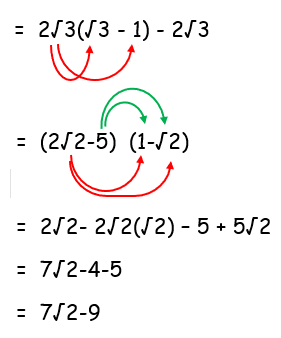EXPAND AND SIMPLIFY WITH RADICALS
Subscribe to our ▶️ YouTube channel 🔴 for the latest videos, updates, and tips.
Expansion can be done using two ways.
(i) Using distribution
(ii) Using algebraic identities.
Expand and simplify :
Problem 1 :
2√3(4-√3)
Solution :

= (2√3 ⋅ 4) – (2√3 ⋅ √3)
= 8√3 – 6
So, the answer is 8√3–6.
Problem 2 :
- √2(2-√2)
Solution :
-√2(2-√2) = - 2√2 + (√2 ⋅ √2)
= - 2√2 + 2
= 2 - 2√2
So, the answer is 2-2√2.
Problem 3 :
2√3(√3 - 1) - 2√3
Solution :

= (2√3 ⋅ √3) – 2√3 - 2√3
= 6 - 2√3 - 2√3
= 6 - 4√3
So, the answer is 6 - 4√3.
Problem 4 :
(2√2 - 5)(1 - √2)
Solution :

Problem 5 :
(3 + 2√5)(2 - √5)
Solution :
By using distributive property,
We get,
= (3 + 2√5)(2 - √5)
= 6 - 3√5 + 4√5 – (2⋅5)
= 6-10-3√5+4√5
= - 4+√5
= √5-4
So, the answer is √5-4.
Problem 6 :
(4 - √2)(3 + 2√2)
Solution :
By using distributive property,
We get,
= (4 - √2)(3 + 2√2)
= (4 ⋅ 3) + (4 ⋅ 2√2) - (√2 ⋅ 3) – (√2 ⋅ 2√2)
= 12 + 8√2 - 3√2 – (2 ⋅ 2)
= 12 + 8√2 - 3√2 – 4
= 8 + 5√2
So, the answer is 8 + 5√2.
Problem 7 :
(3 - √7)2
Solution :
By comparing the given question with the algebraic identity (a-b)2, we get
(a-b)2 = a2-2ab+b2
Here a = 3 and b = √7
= 32 – (2 ⋅ 3 ⋅ √7) + (√7)2
= 9-6√7+7
= 16-6√7
So, the answer is 16 - 6√7.
Problem 8 :
- (2 - √5)2
Solution :
By comparing the given question with the algebraic identity (a-b)2, we get
(a-b)2 = a2-2ab+b2
= - (2 - √5)2
= - [22 – (2⋅ 2⋅ √5) + (√5)2]
= - [4-4√5+5]
= - [9-4√5]
= - 9+4√5
= 4√5-9
So, the answer is 4√5-9.
Problem 9 :
(2 - √3)(2 + √3)
Solution :
By comparing the given question with algebraic identity a2-b2, we get
a2-b2 = (a+b)(a-b)
Here a = 2 and b = √3
= (2 - √3)(2 + √3)
= (2)2 – (√3)2
= 1
So, the answer is 1.
Problem 10 :
(5 - √3)(5 + √3)
Solution :
By using algebraic identity,
We get,
= (5 - √3)(5 + √3)
= (5)2 – (√3)2
= 22
So, the answer is 22.
Problem 11 :
Write √1/7 in the form k√7
Solution :
Given, √1/7
= 1/√7 ⋅ (√7/√7)
= √7/7
= (1/7) √7
The value of k is 1/7.
Problem 12 :
Find x, y ∈ Q such that (3+x√5) (√5–y) = - 13+5√5
Solution :
(3 + x√5) (√5 – y) = - 13 + 5√5
3√5 – 3y + 5x - xy√5 = - 13 + 5√5
5x – 3y + √5(3 - xy) = - 13 + 5√5
Equating corresponding terms, we get
5x – 3y = - 13 -----(1)
(3 – xy) = 5
- xy = 2
y = - 2/x -----(2)
By applying y = - 2/x in (1),
We get,
5x – 3y = - 13
5x – 3(- 2/x) = - 13
5x + (6/x) = - 13
5x2 + 6 = - 13x
5x2 + 13x + 6 = 0
By factorization, we get
5x2 + 10x + 3x + 6 = 0
5x(x+2) + 3(x+2) = 0
(5x+3) (x+2) = 0
|
5x+3 = 0 x = -3/5 |
x+2 = 0 x = -2 |
By applying x = - 2 in (2),
We get,
y = -2/x
y = 1
So, the value of x = - 2 and y = 1
Problem 13 :
Find p, q ∈ Q such that (p + 3√7) (5 + q√7) = 9√7 - 53
Solution :
(p + 3√7) (5 + q√7) = 9√7 - 53
5p + pq√7 + 15√7 + (3q . 7) = 9√7 – 53
(5p+21q) + √7(pq+15) = 9√7 - 53
By combining like same terms, we get
5p + 21q = - 53 -----(1)
pq + 15 = 9
pq = - 6
q = - 6/p -----(2)
By applying q = - 6/p in (1),
We get,
5p + 21q = - 53
5p + 21(- 6/p) = - 53
5p - (126/p) = - 53
5p2 - 126 = - 53p
5p2 + 53p - 126 = 0
By factorization, we get
5p2 – 10p + 63p - 126 = 0
5p(p - 2) + 63(p - 2) = 0
(5p + 63) (p - 2) = 0
|
5p + 63 = 0 p = -63/5 q = - 6/(-63/5) q = 10/21 |
p - 2 = 0 p = 2 q = -6/2 q = -3 |
Problem 14 :
Solve for m, √(m - 1) + 5 = m - 2
Solution :
√(m - 1) + 5 = m - 2
Subtracting 5 on both sides
√(m - 1) = m - 2 - 5
√(m - 1) = m - 7
Squaring on both sides
(m - 1) = (m - 7)2
m - 1 = m2 - 14m + 49
m2 - 14m - m + 49 + 1 = 0
m2 - 15m + 50 = 0
(m - 10)(m - 5) = 0
Solving for m, we get
m = 10 and m = 5
Subscribe to our ▶️ YouTube channel 🔴 for the latest videos, updates, and tips.
Kindly mail your feedback to v4formath@gmail.com
We always appreciate your feedback.
About Us | Contact Us | Privacy Policy
©All rights reserved. onlinemath4all.com

Recent Articles
-
90 Degree Clockwise Rotation
Jan 01, 26 06:58 AM
90 Degree Clockwise Rotation - Rule - Examples with step by step explanation -
US Common Core K-12 Curriculum Algebra Solving Systems of Equations
Jan 01, 26 04:51 AM
US Common Core K-12 Curriculum - Algebra : Solving Systems of Linear Equations -
Solving the HARDEST SAT Math Questions ONLY using Desmos
Dec 31, 25 05:53 AM
Solving the HARDEST SAT Math Questions ONLY using Desmos
